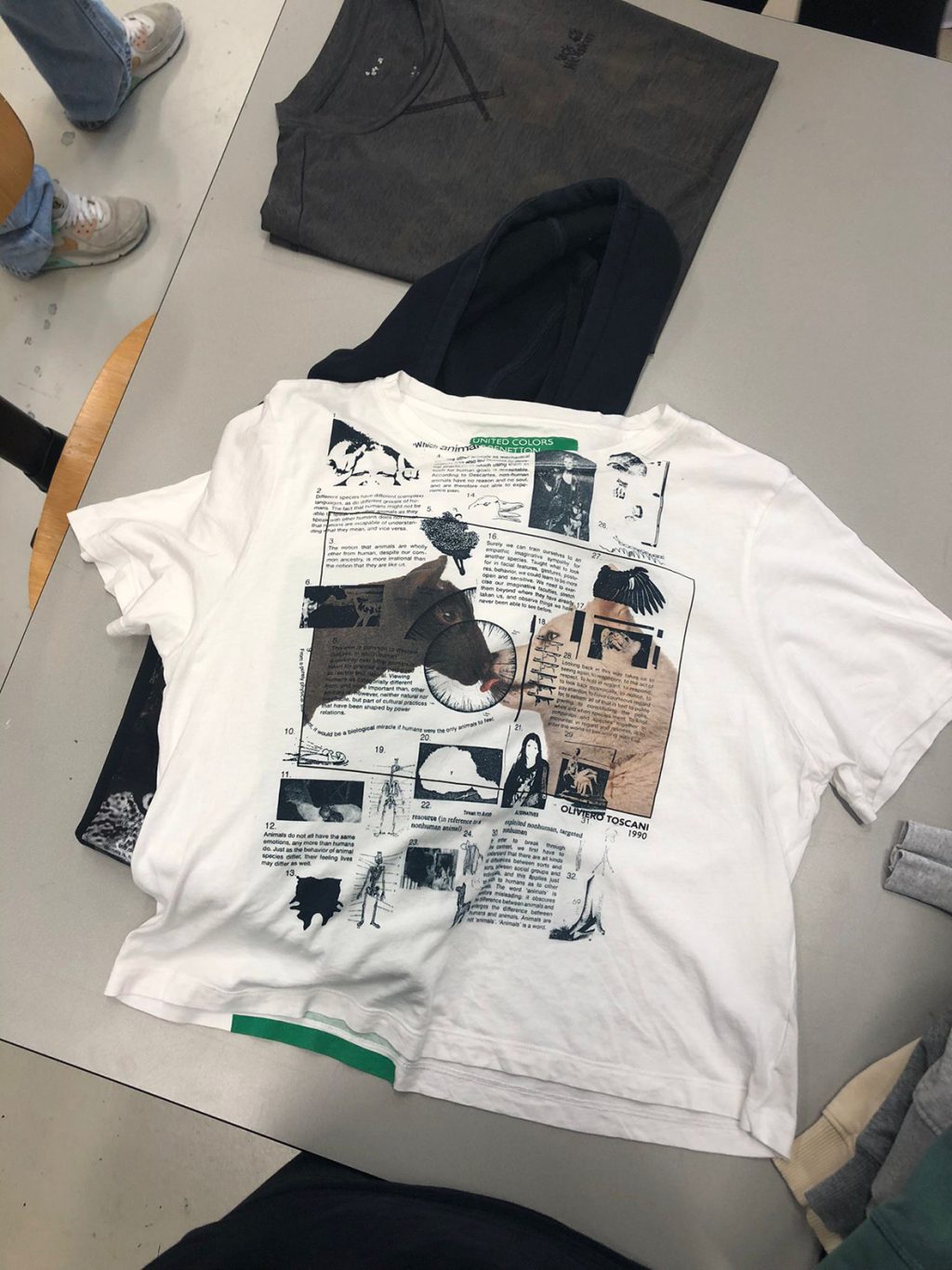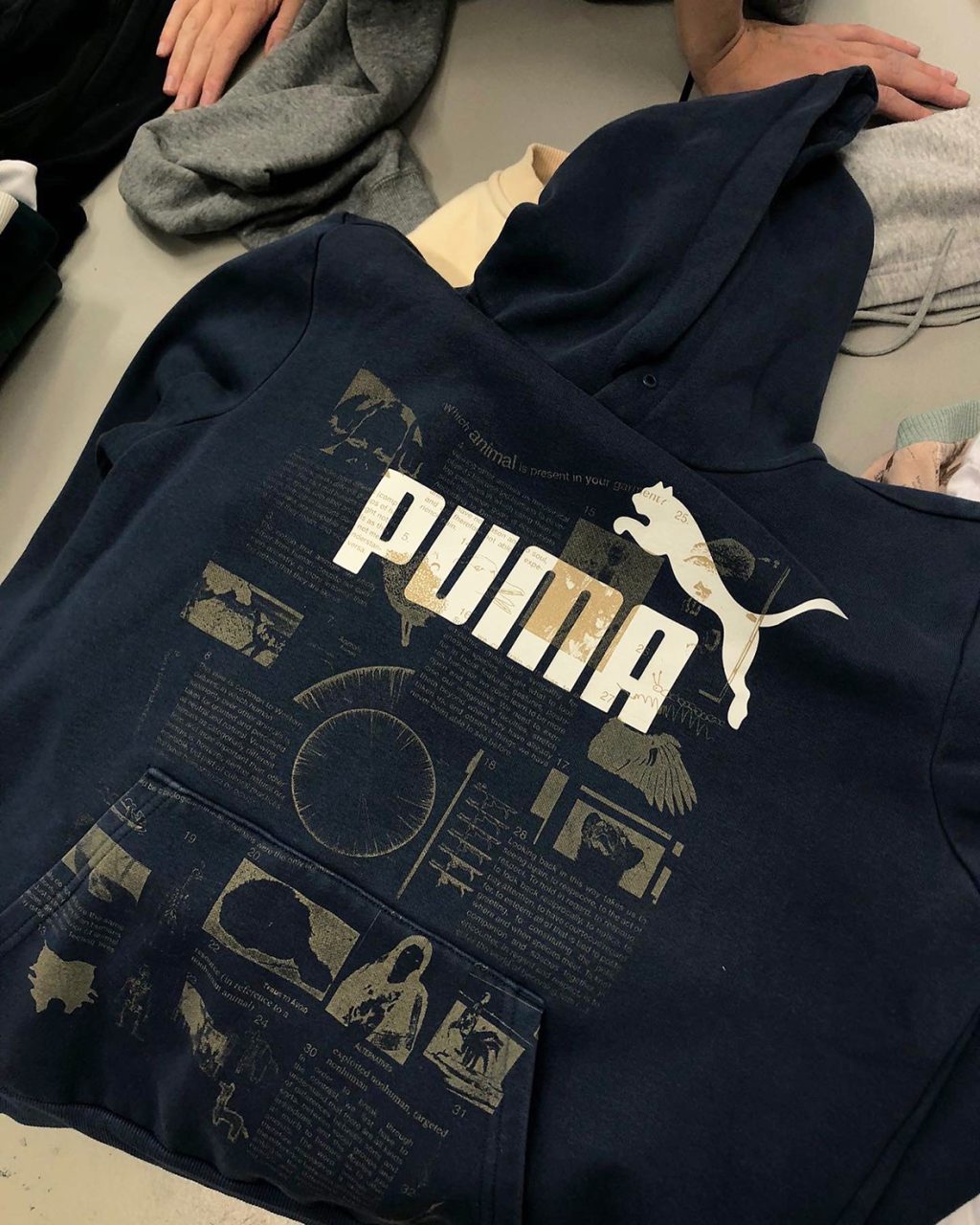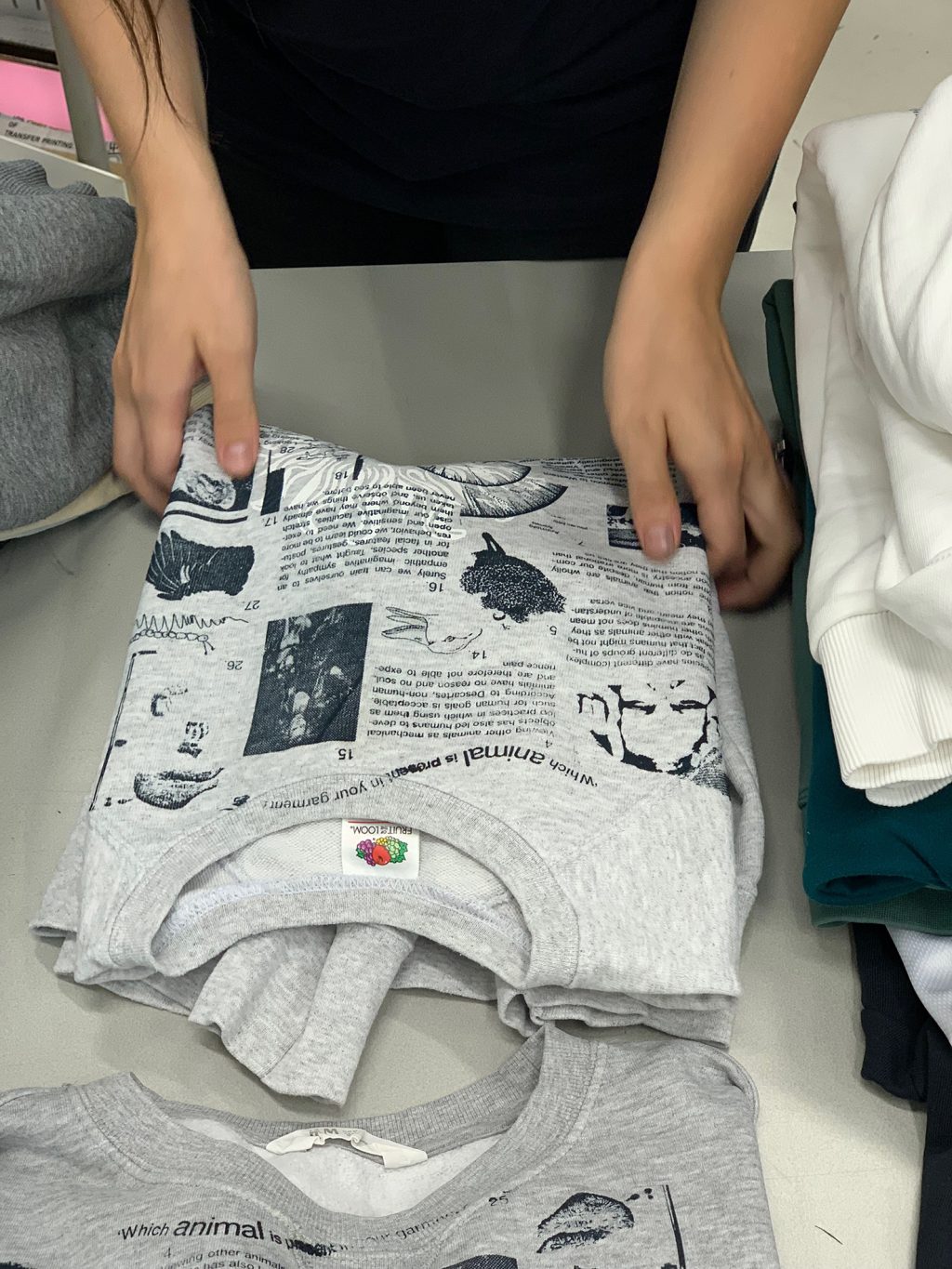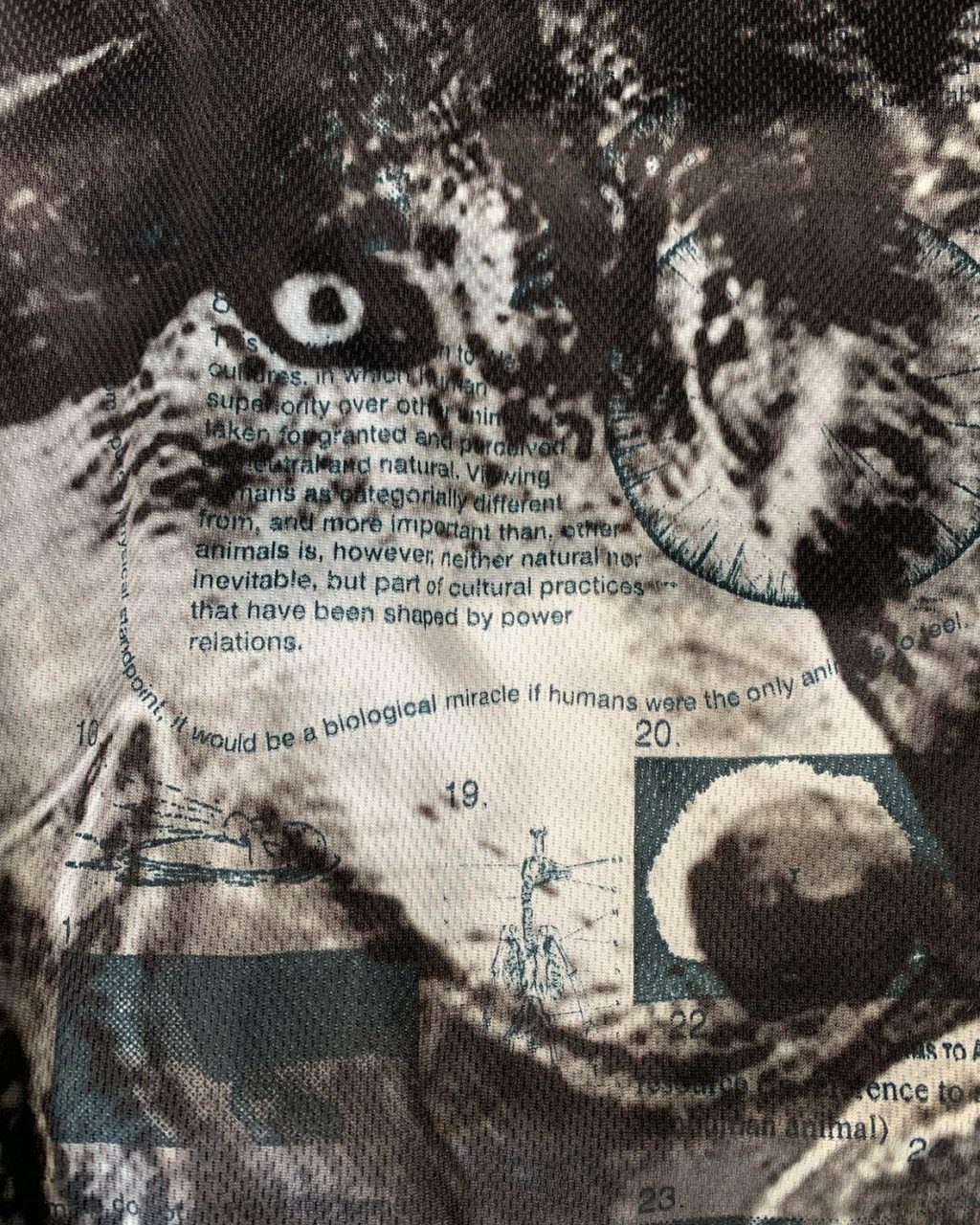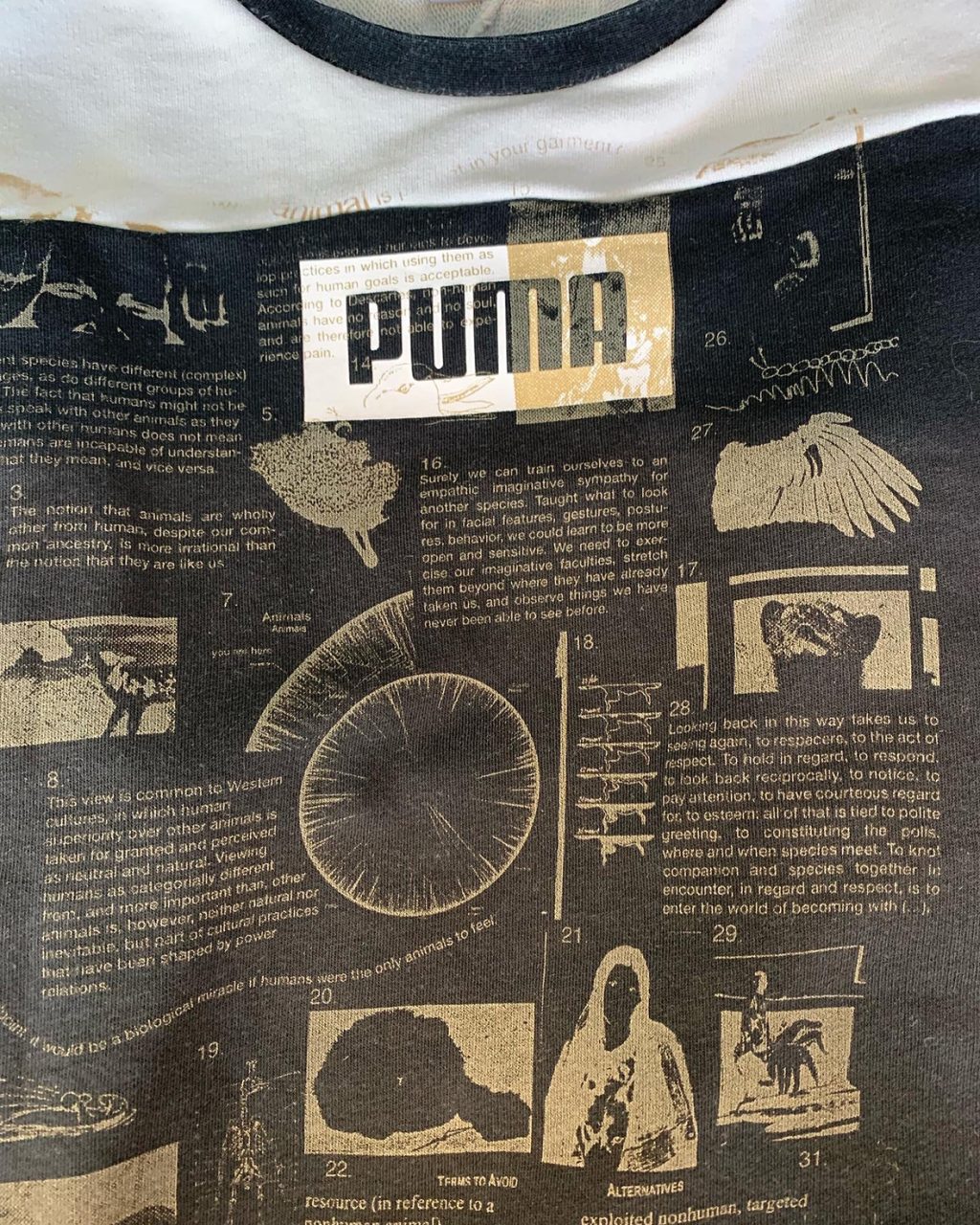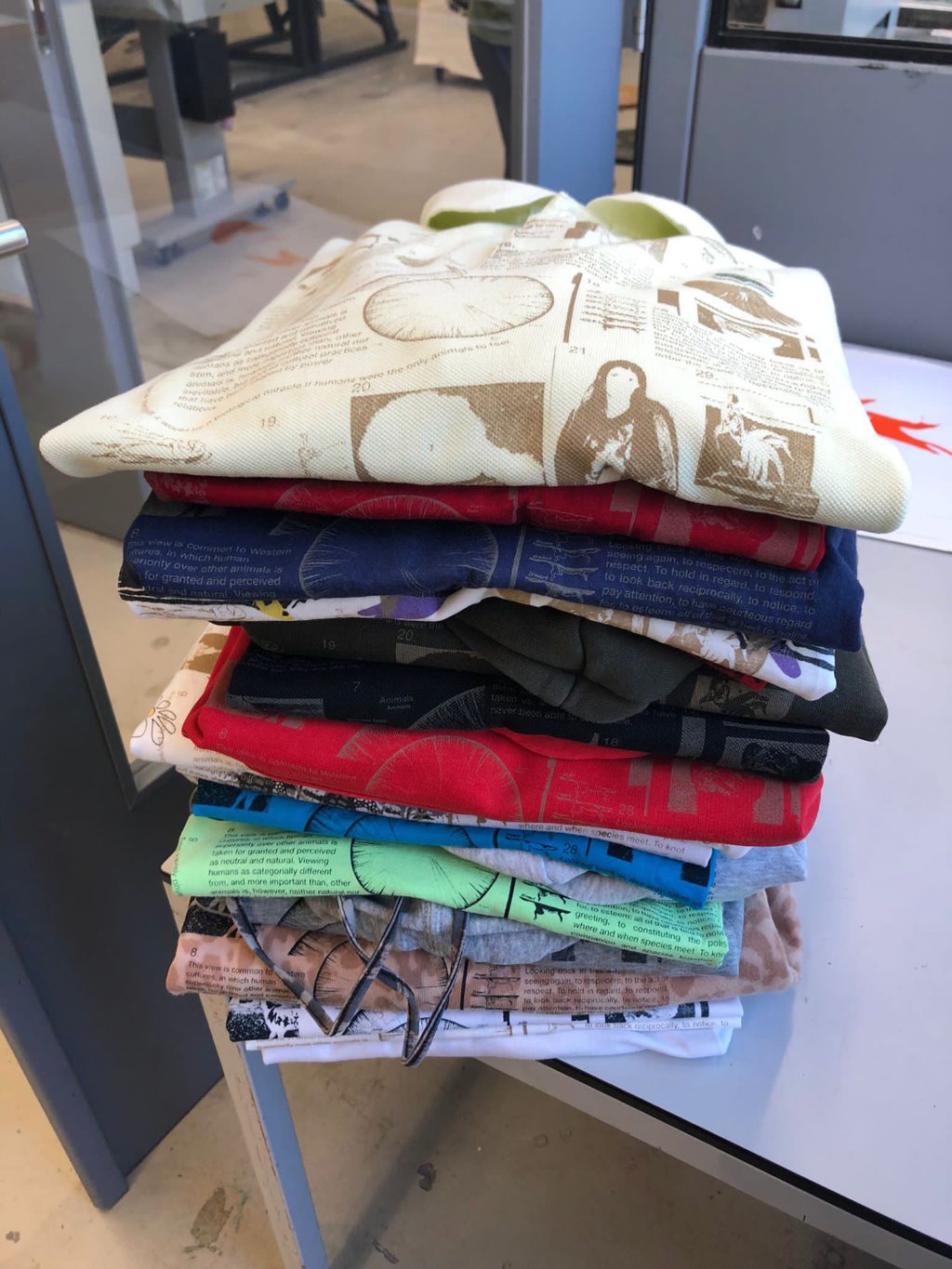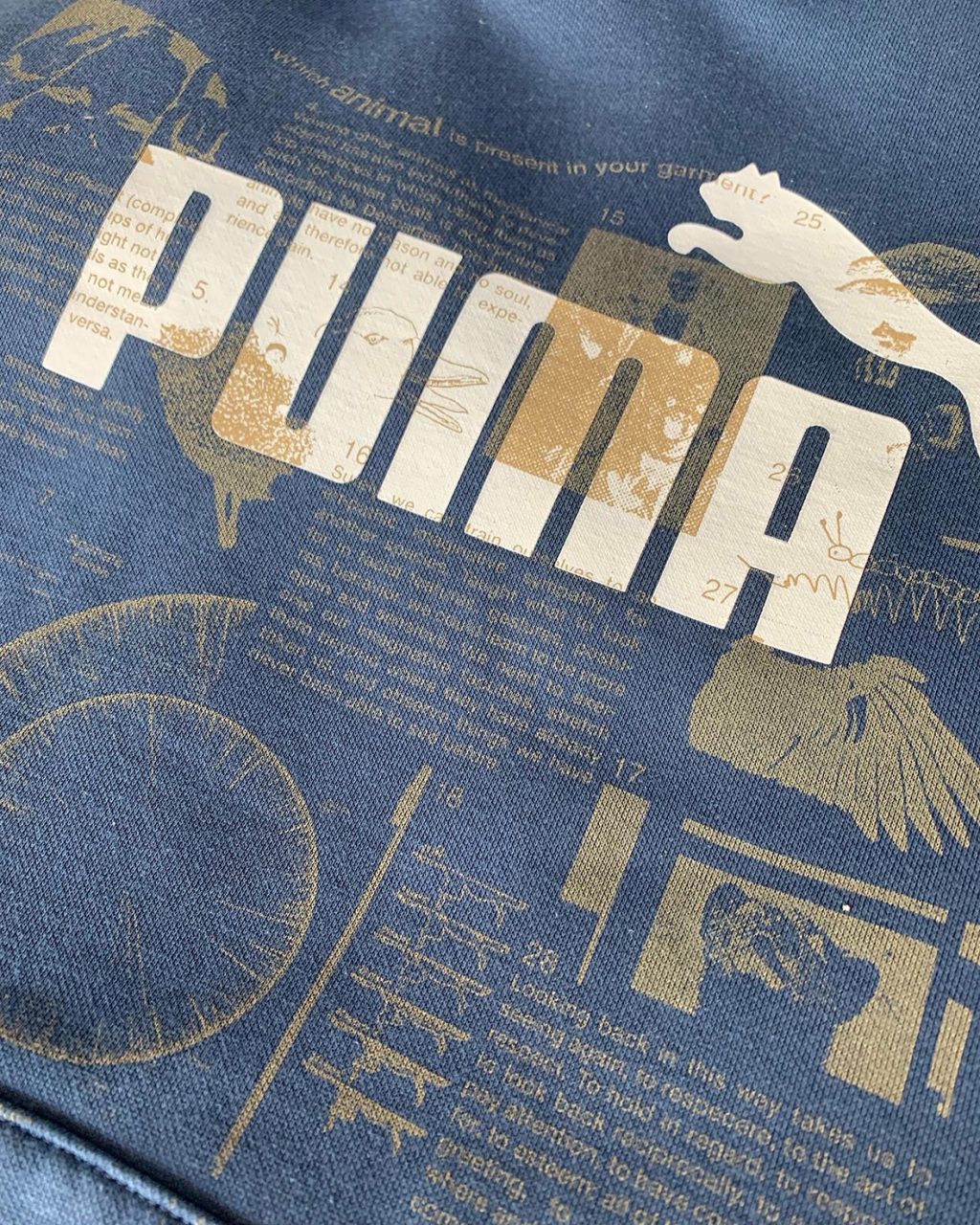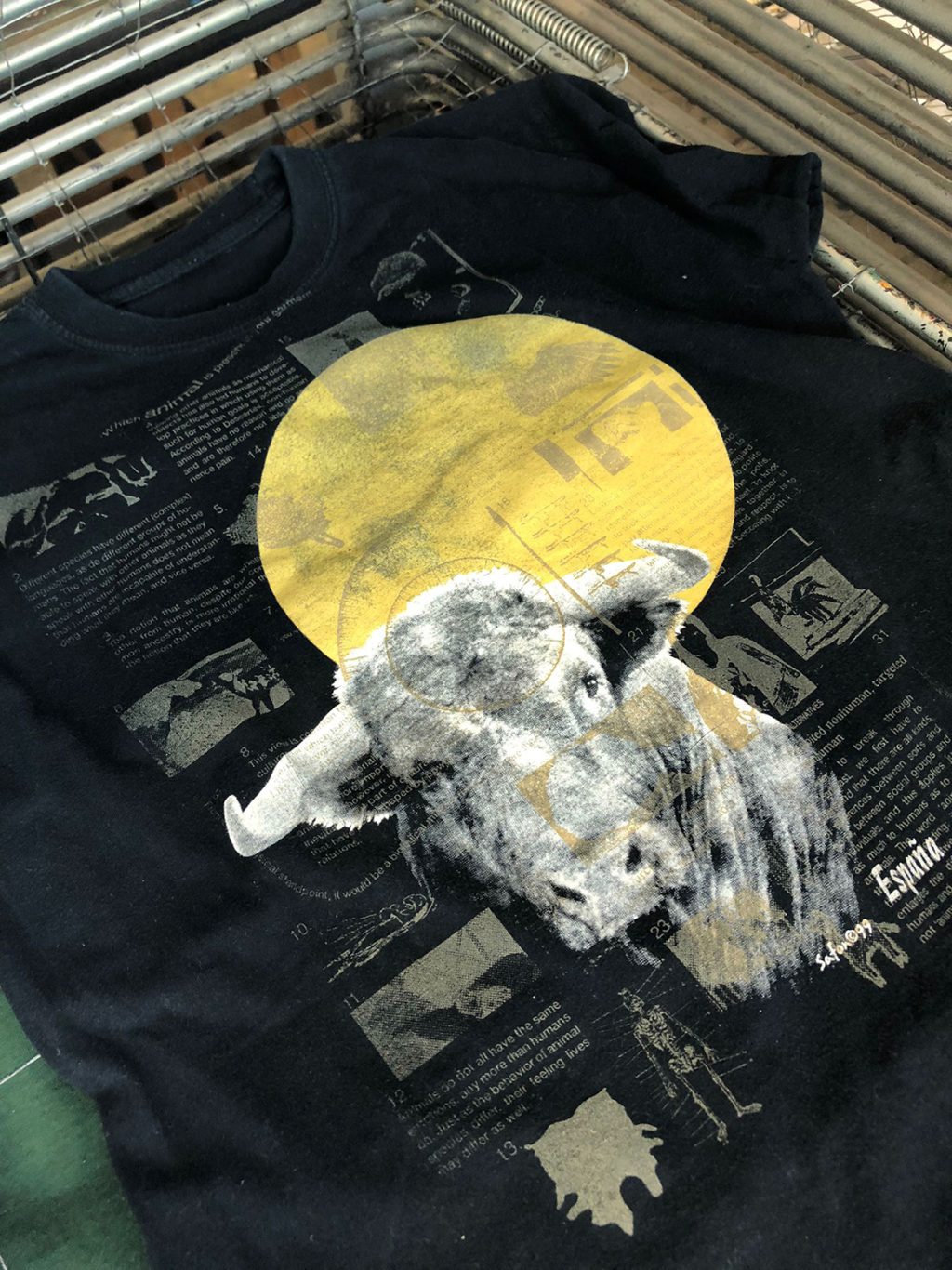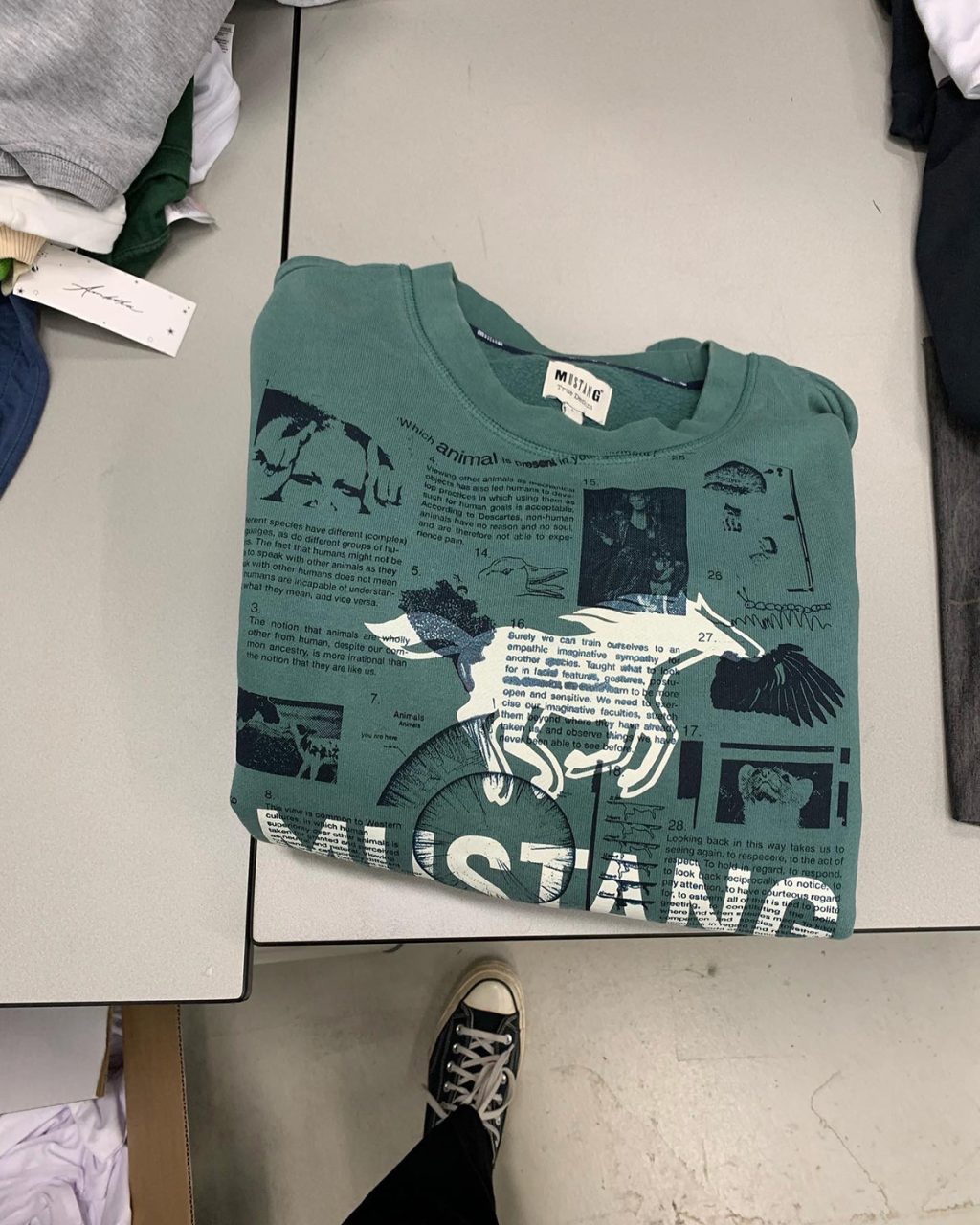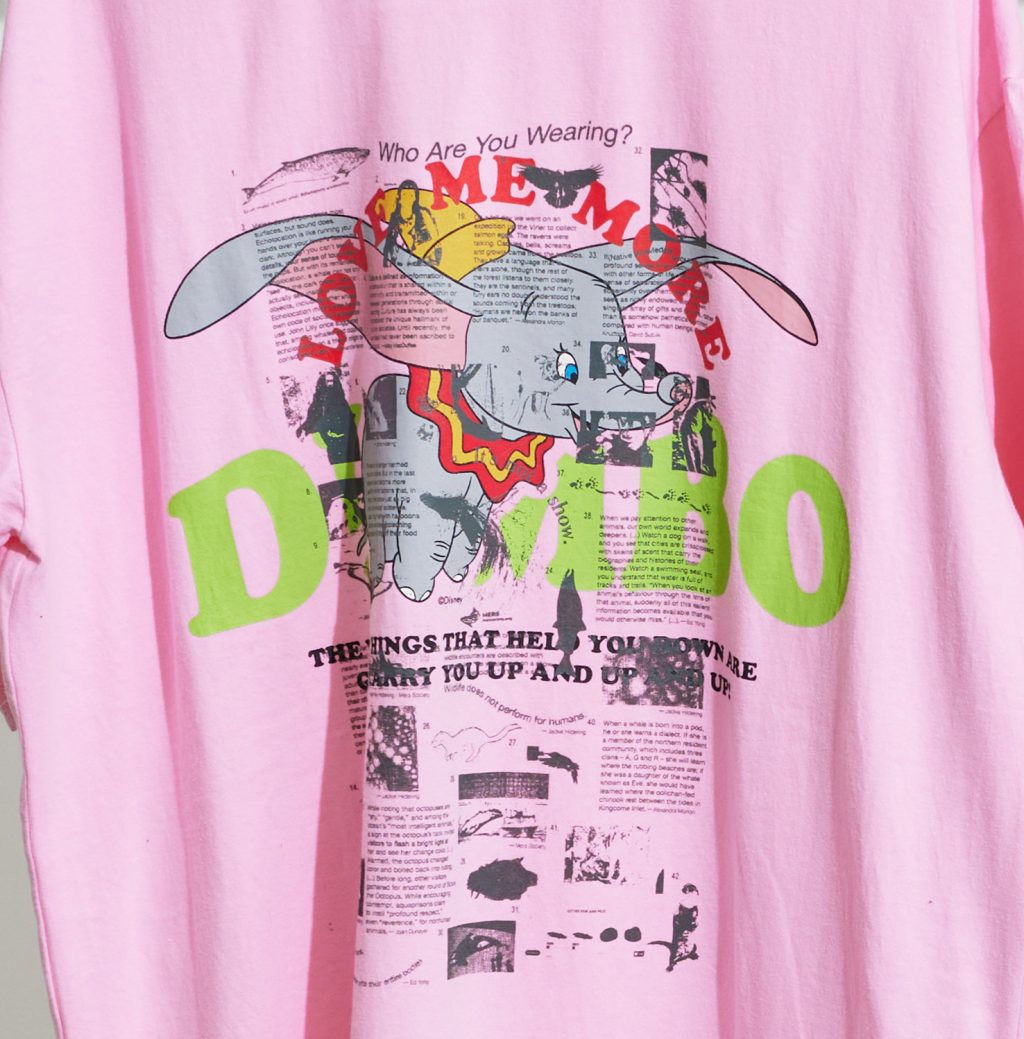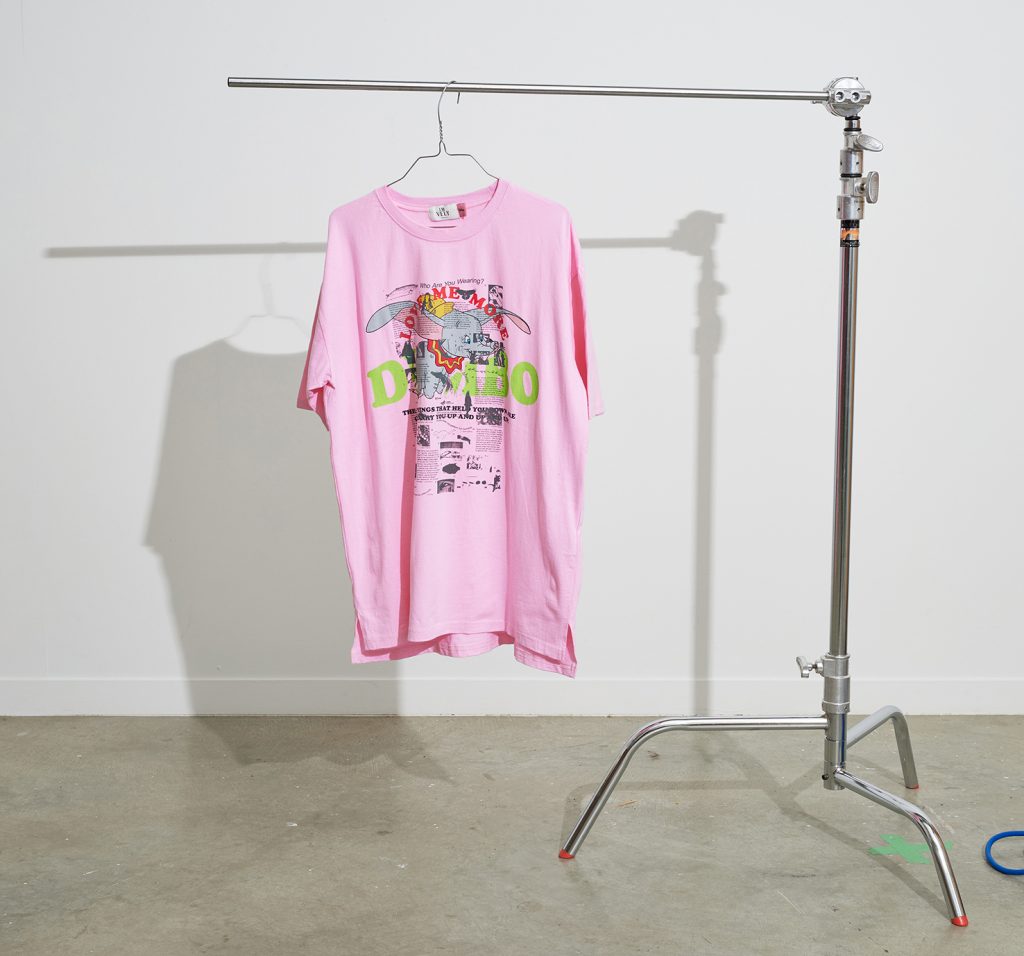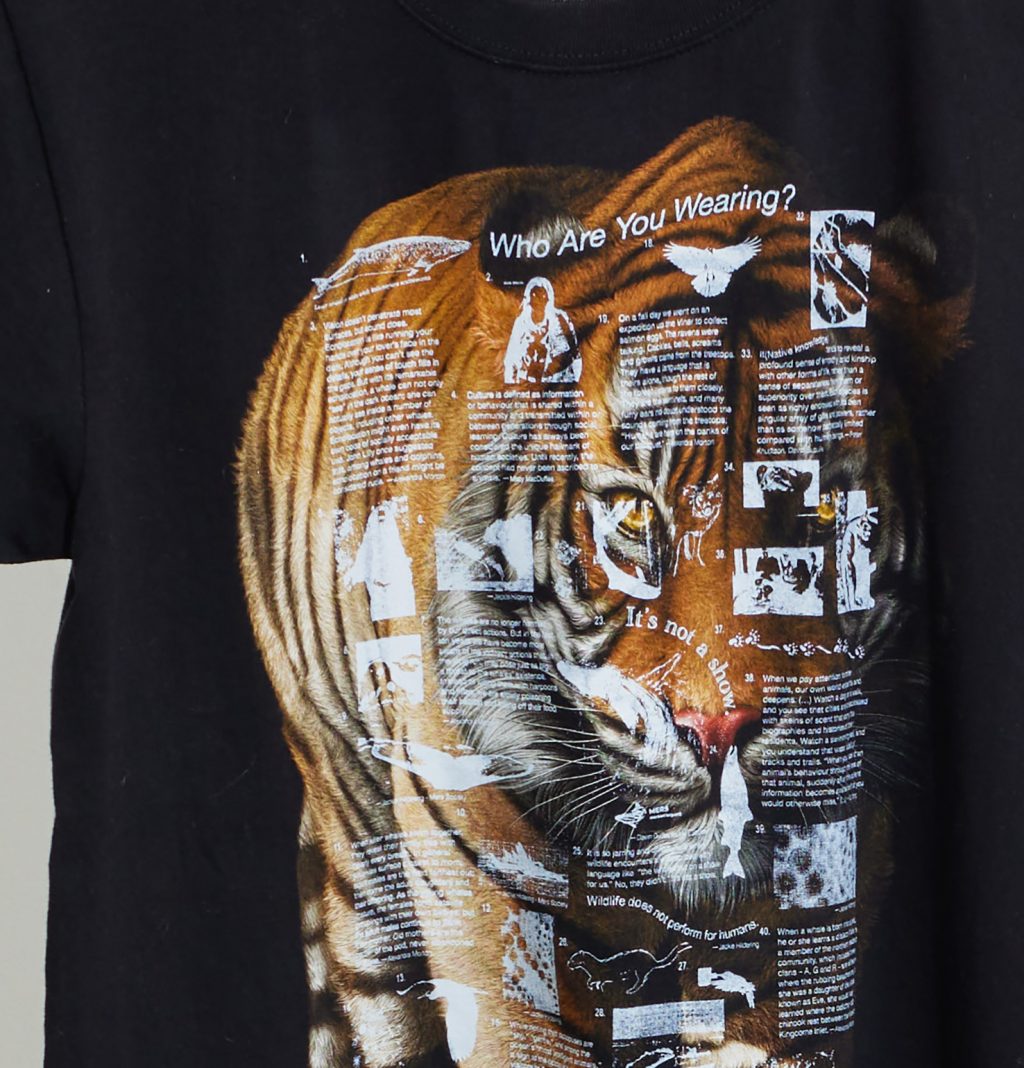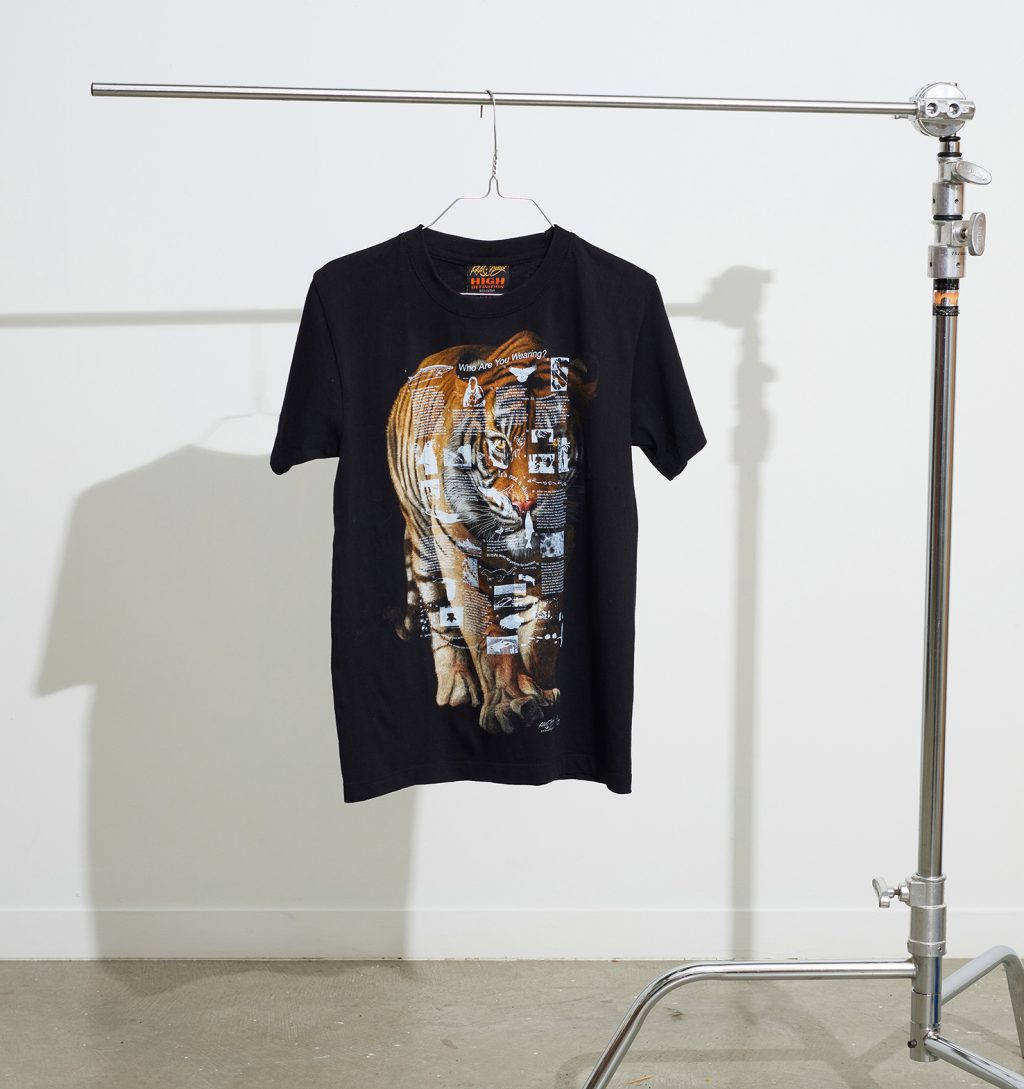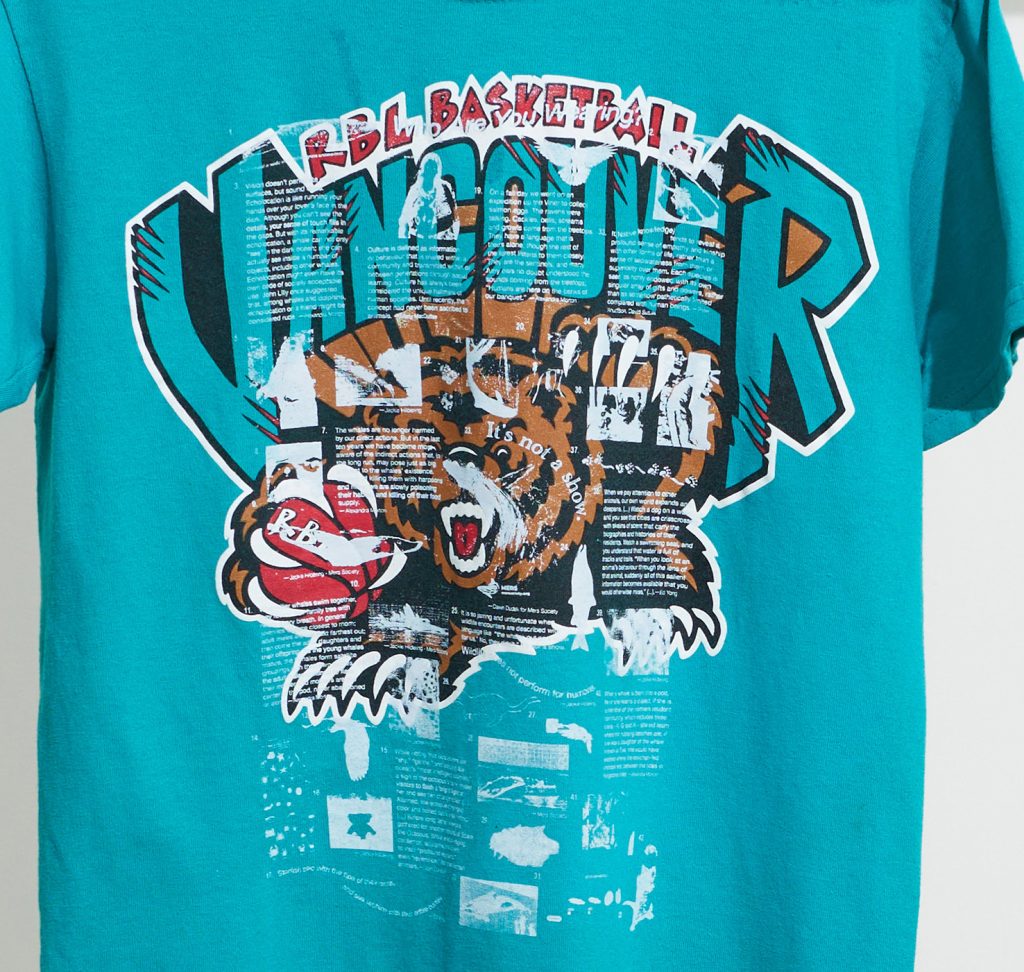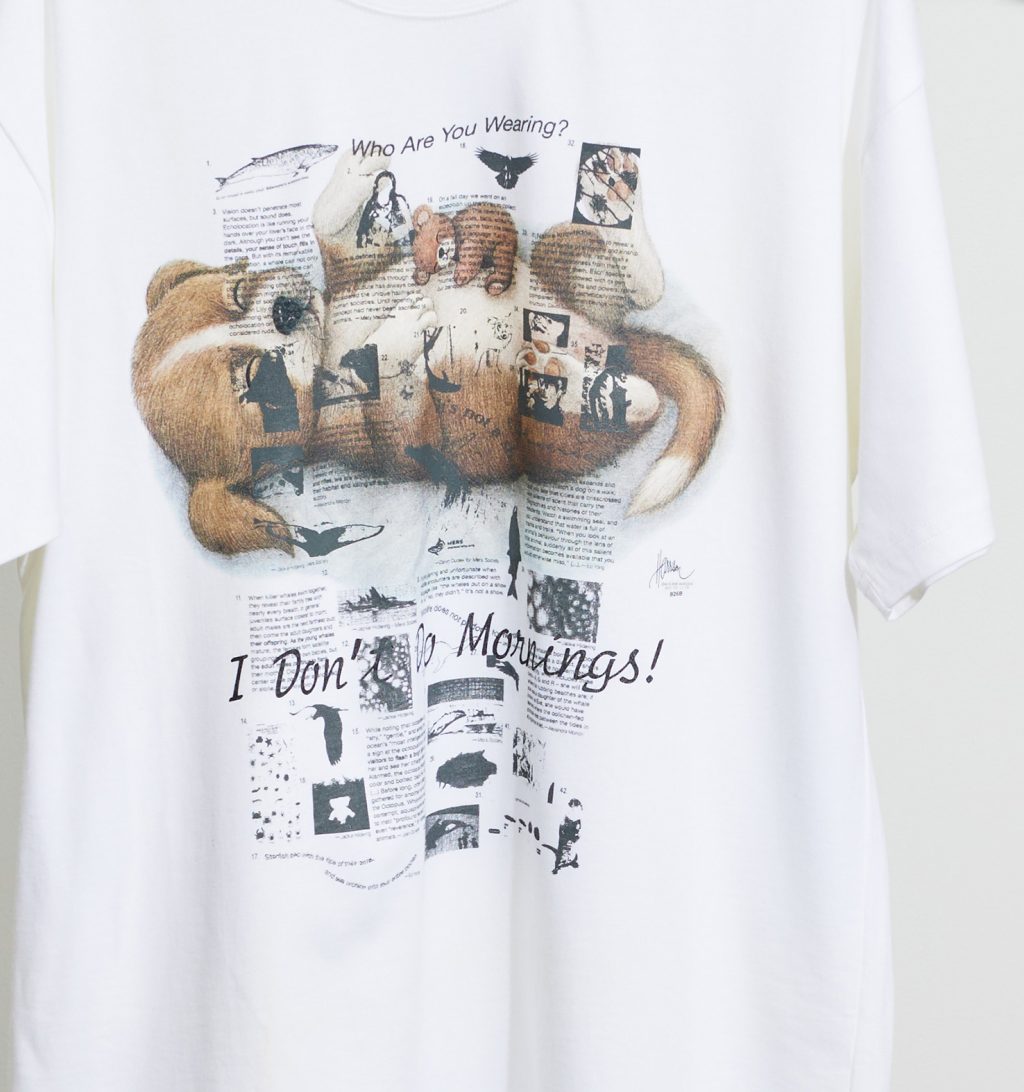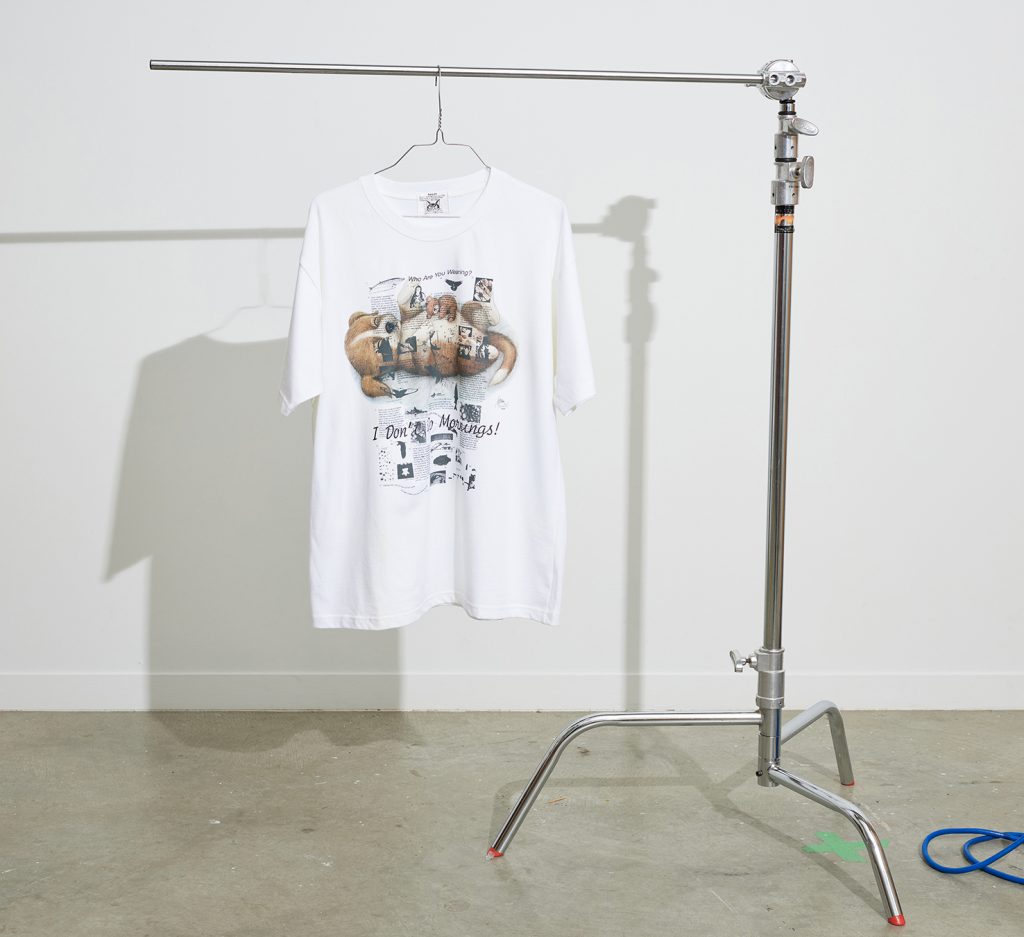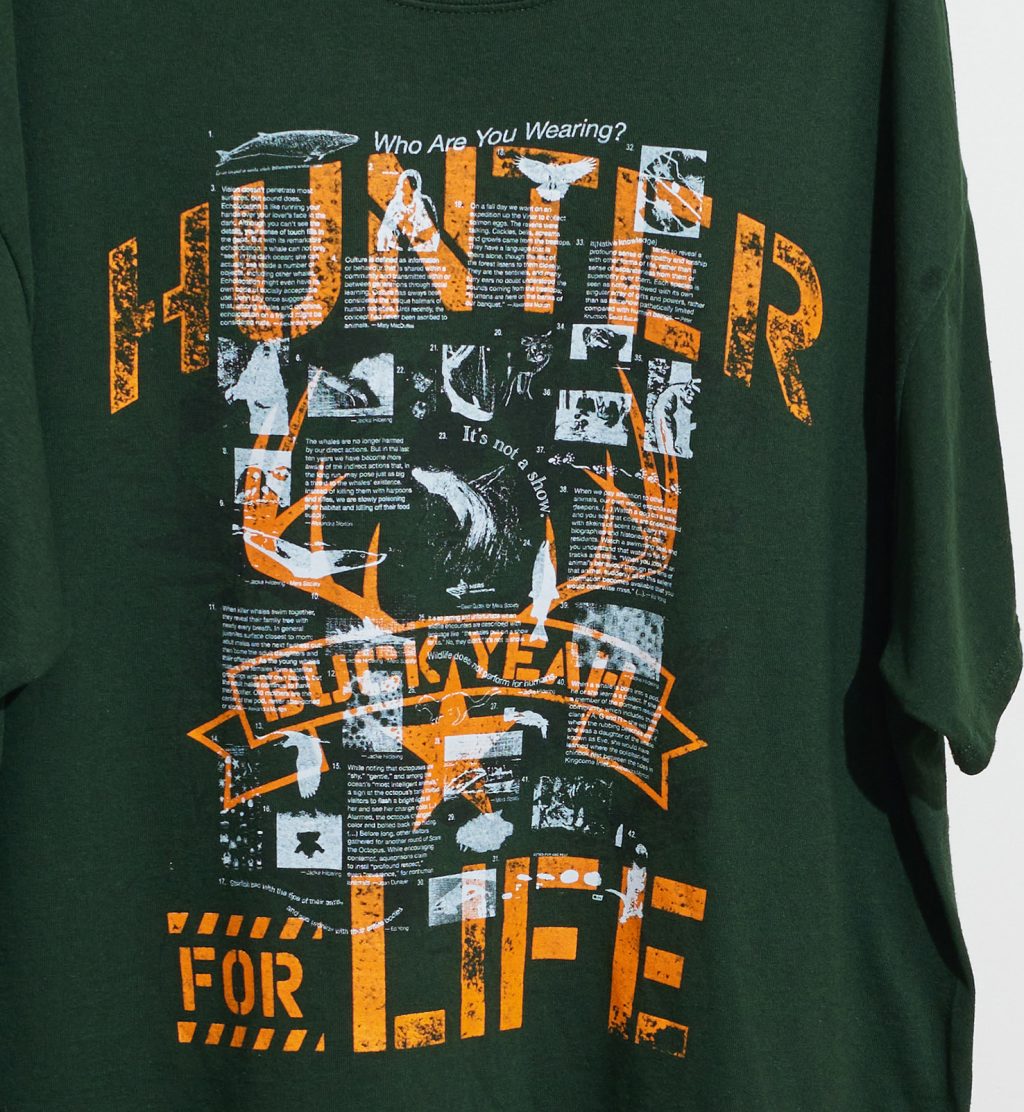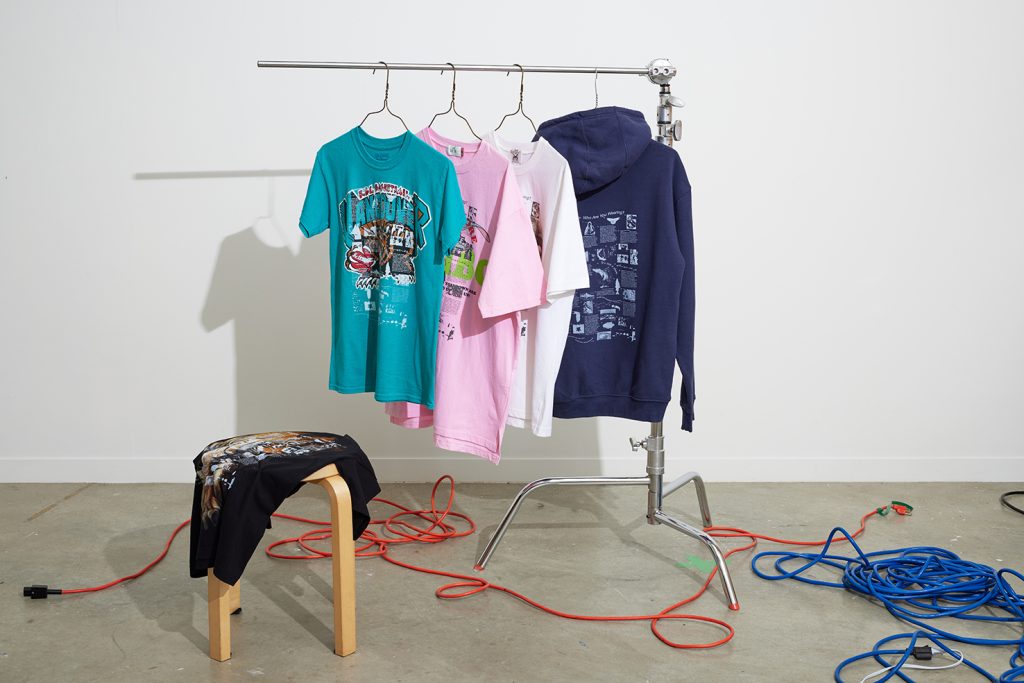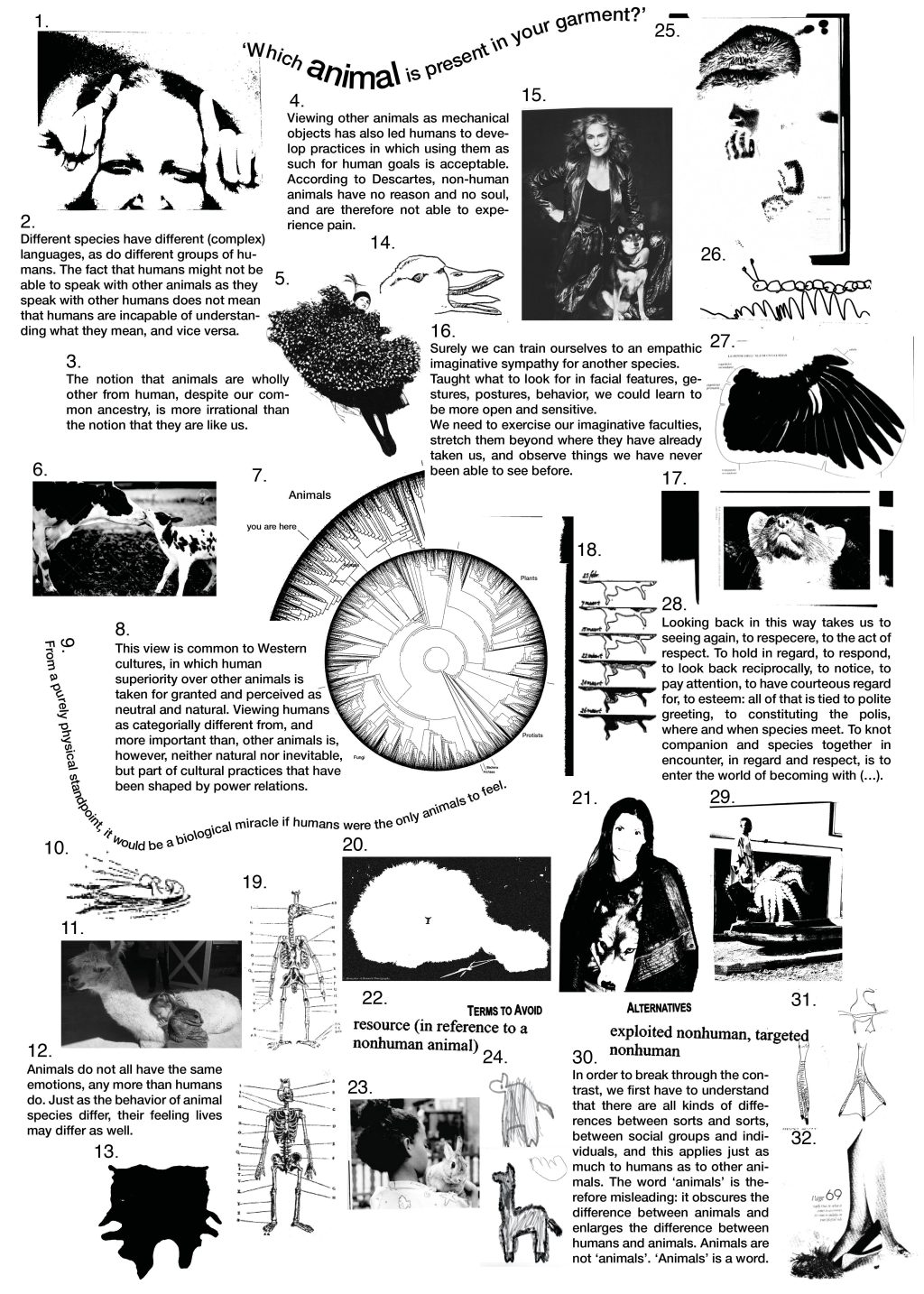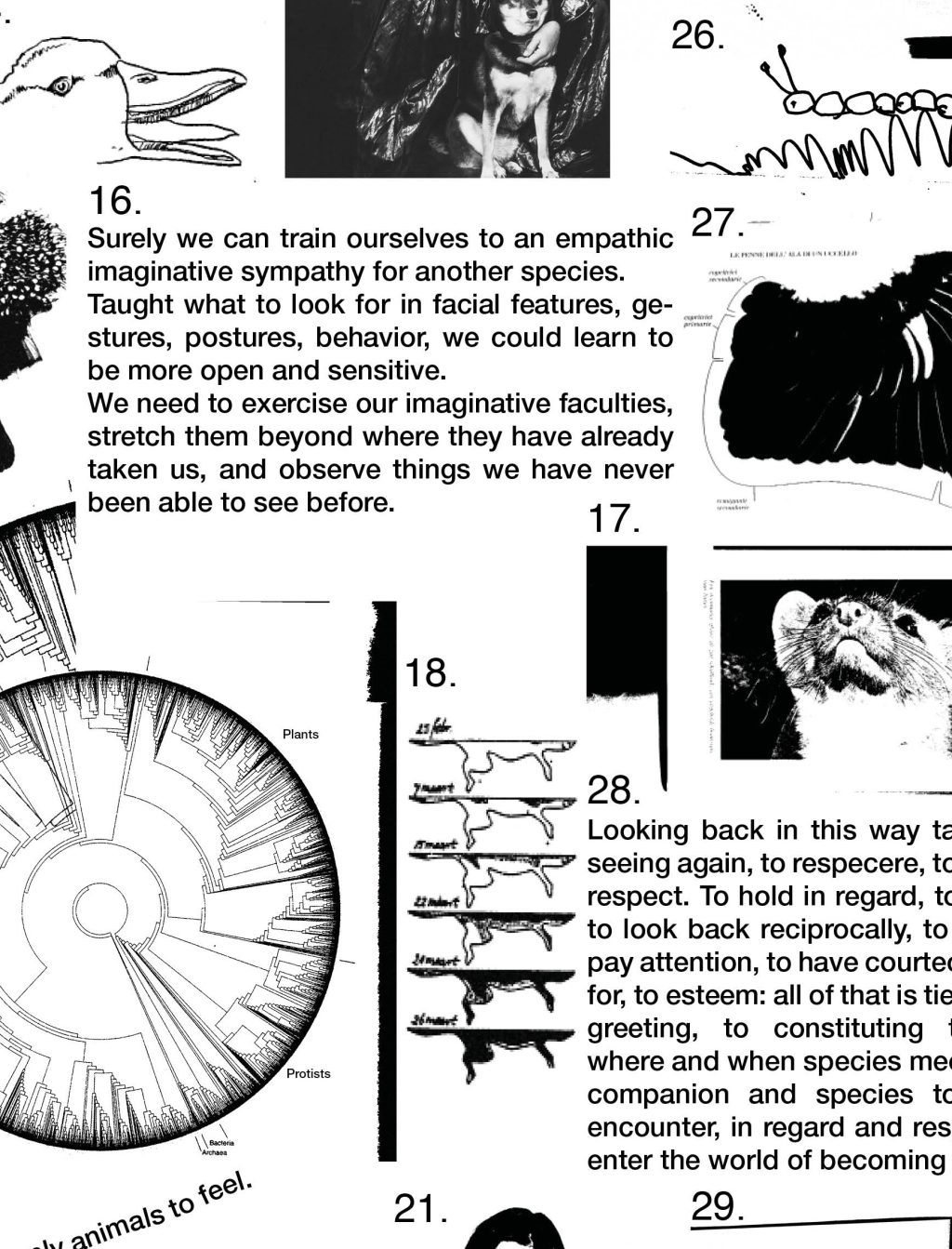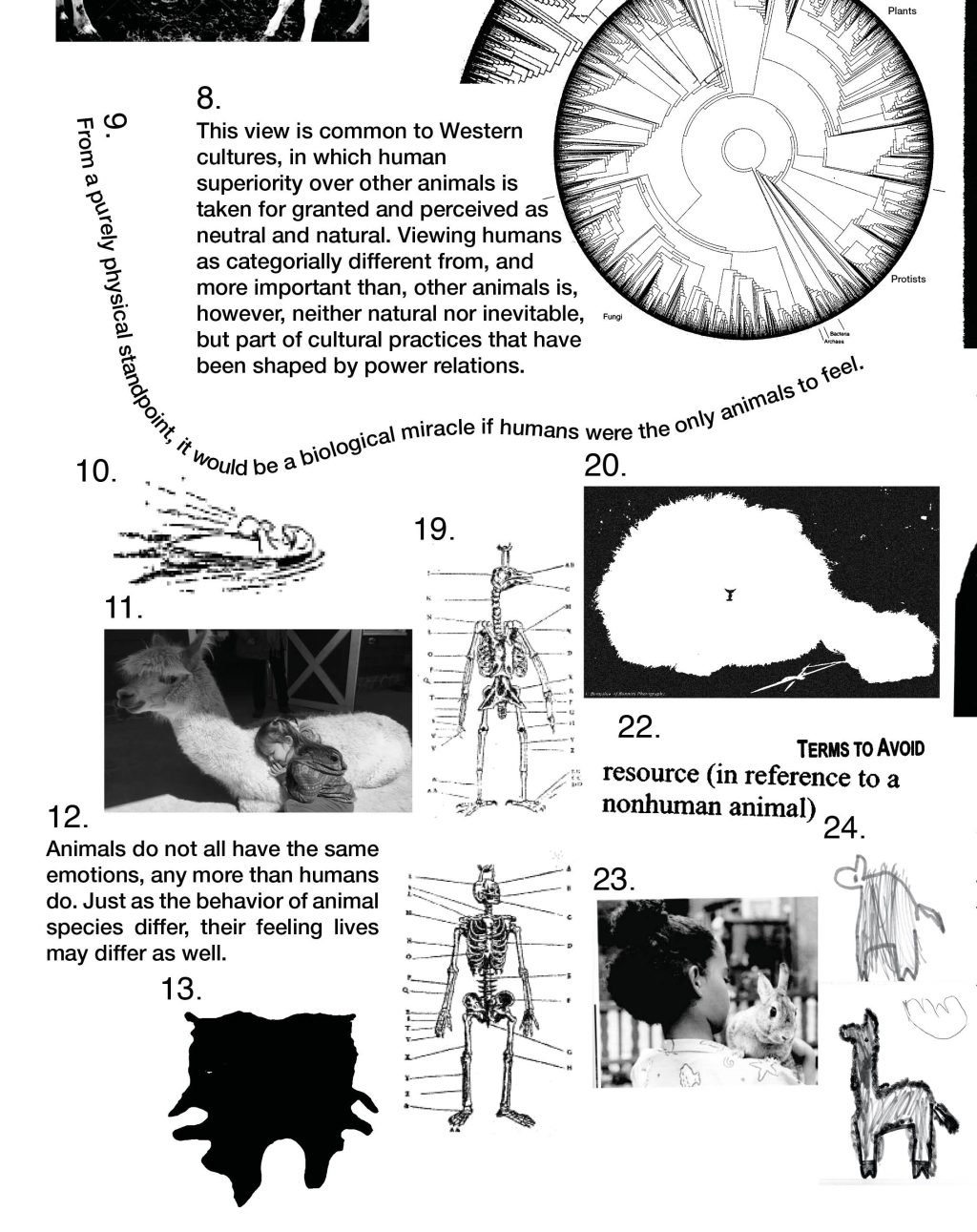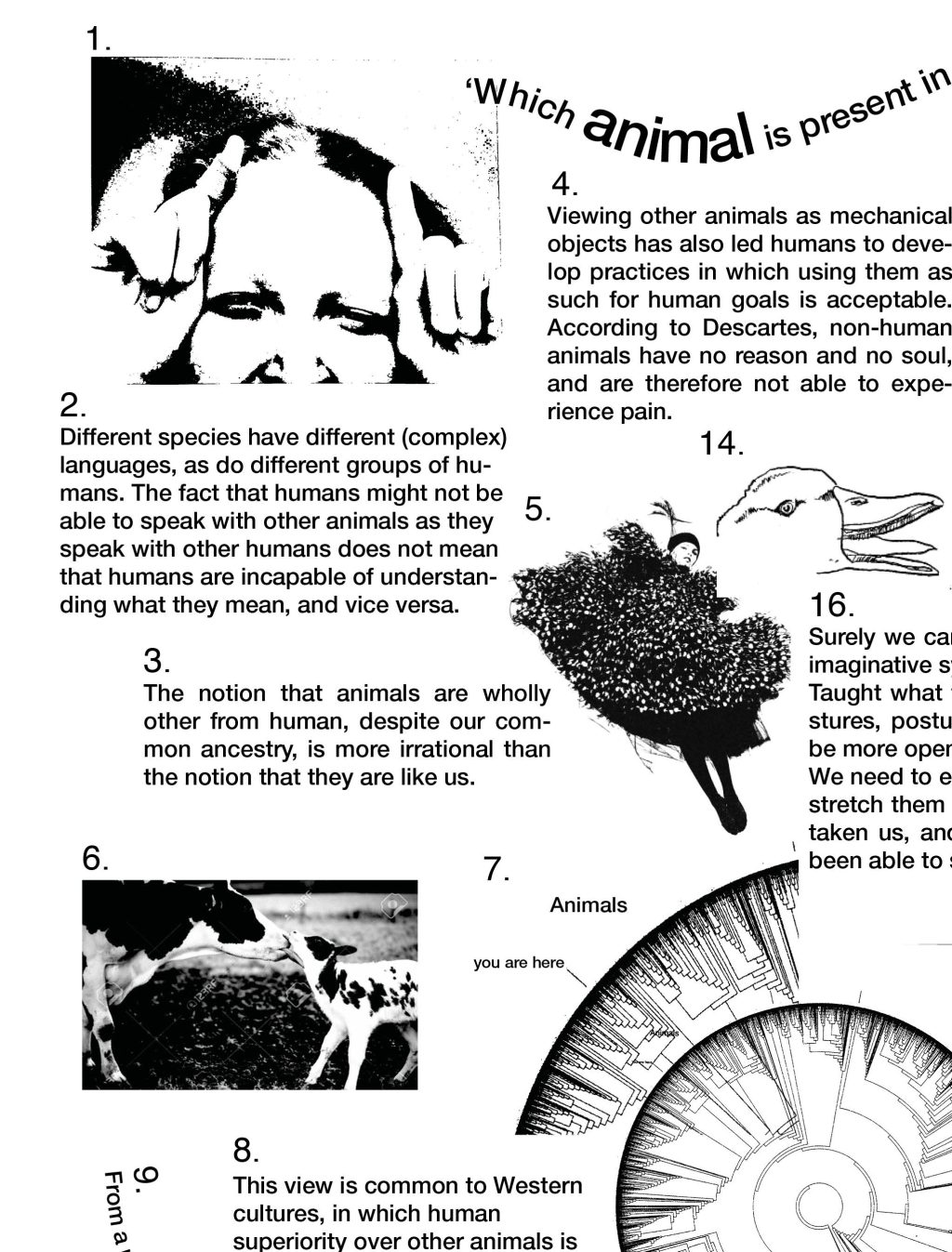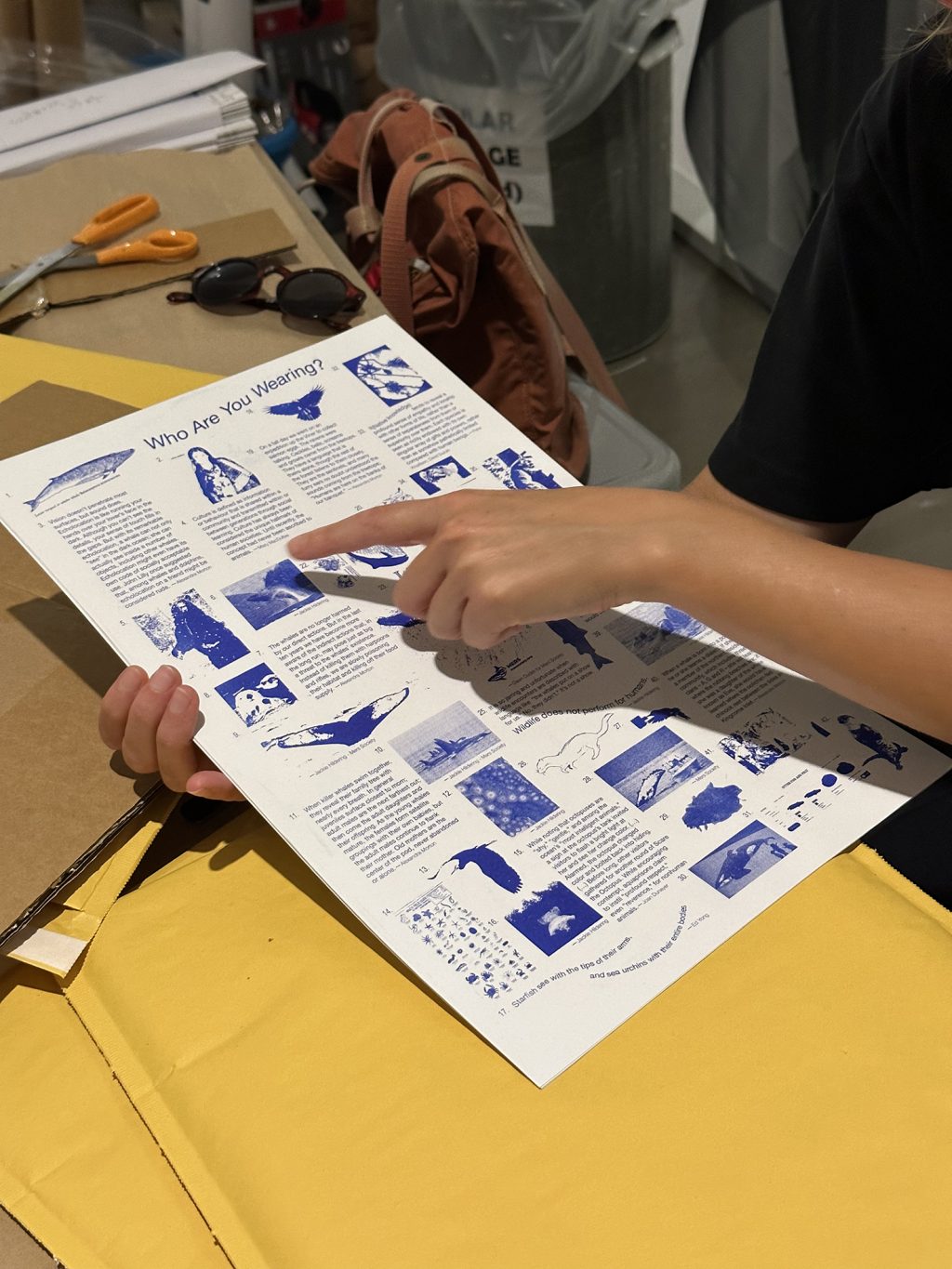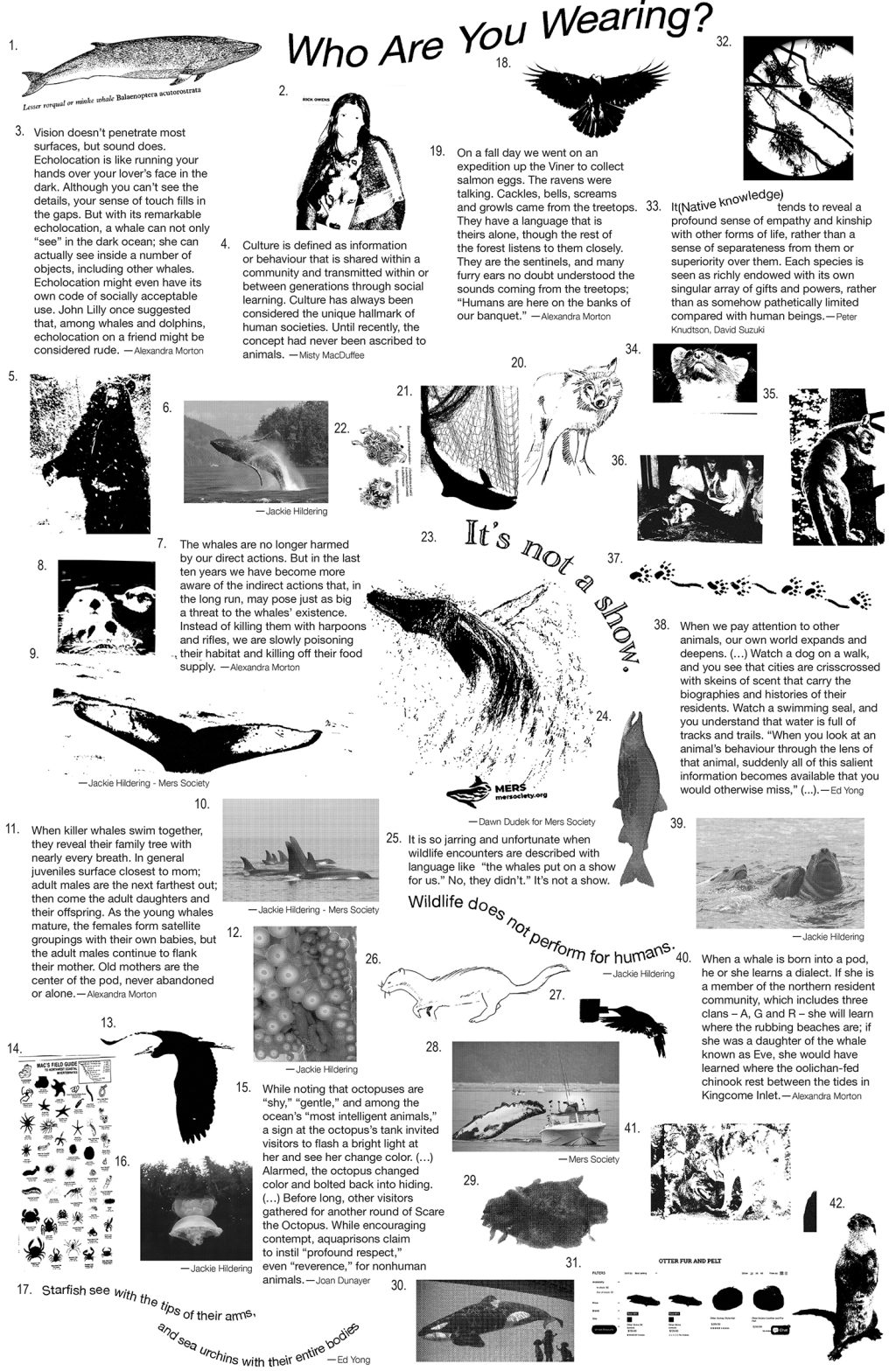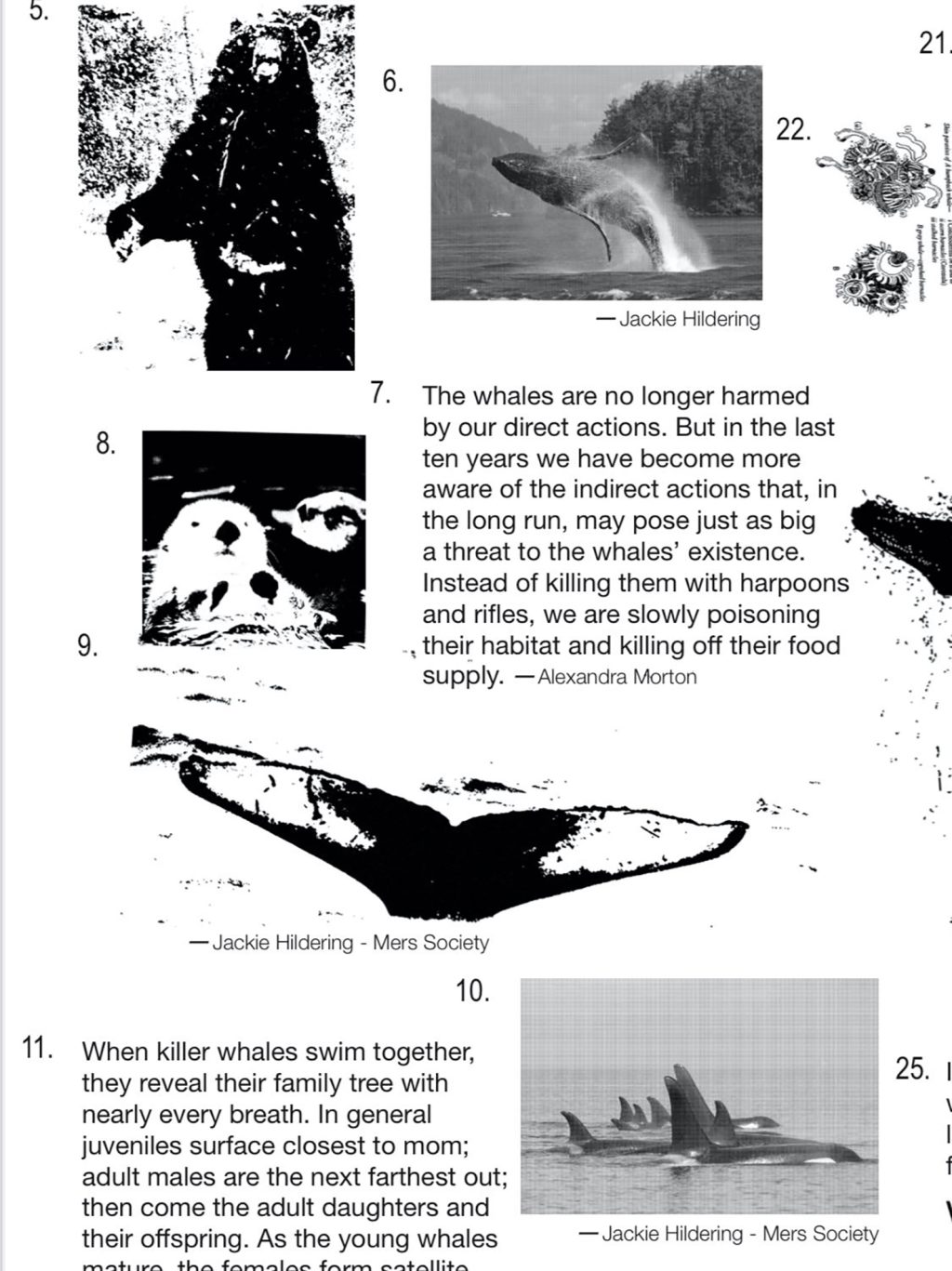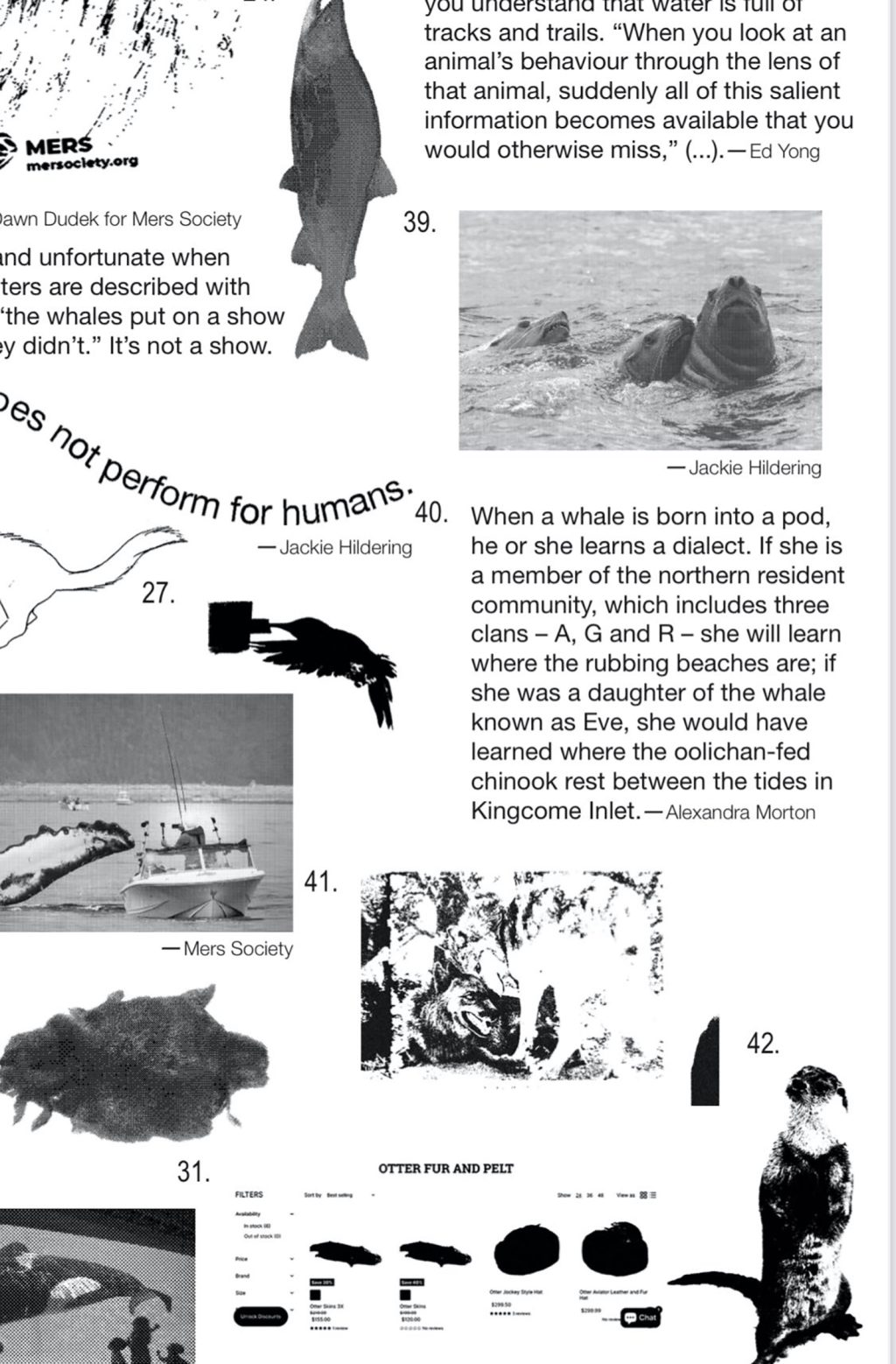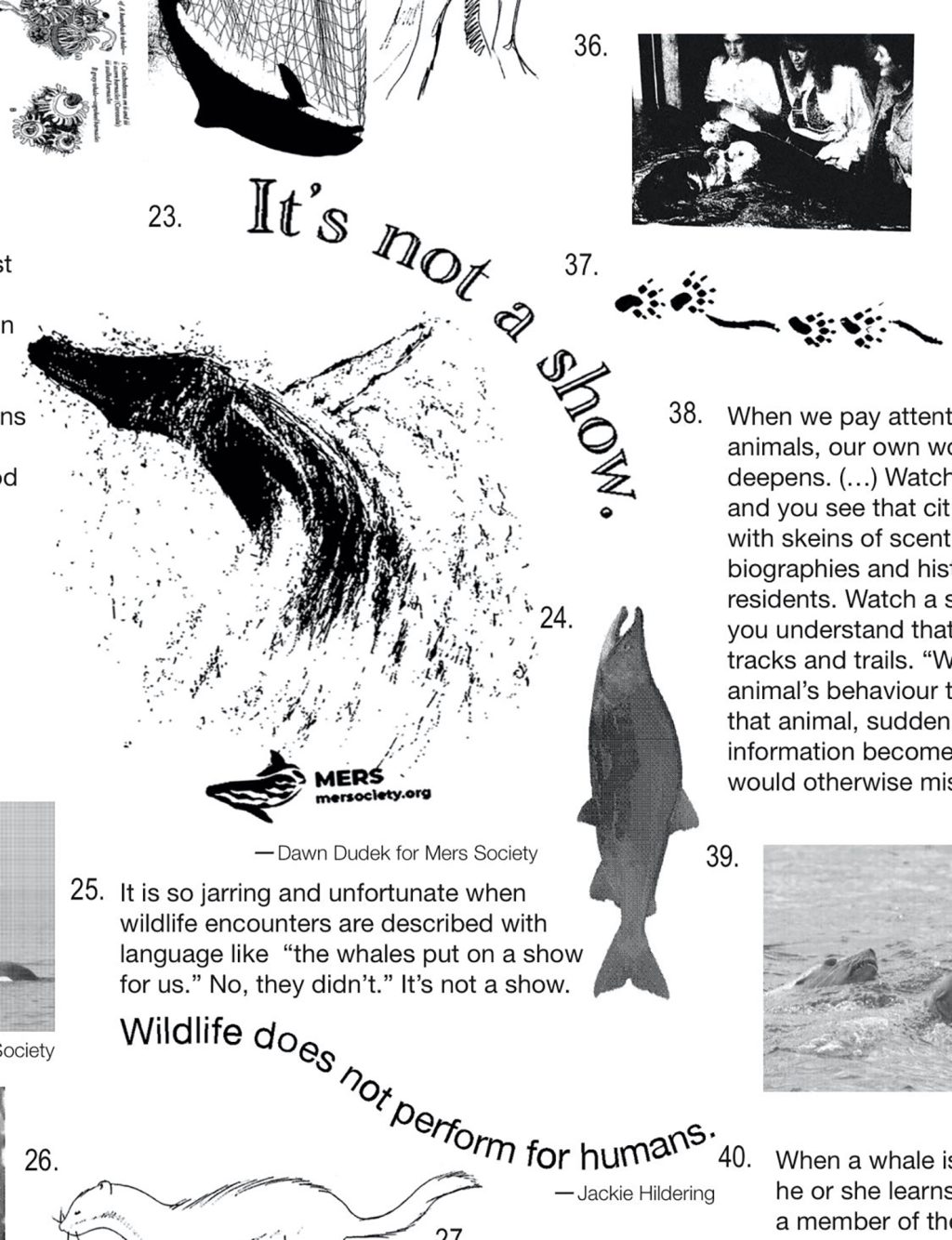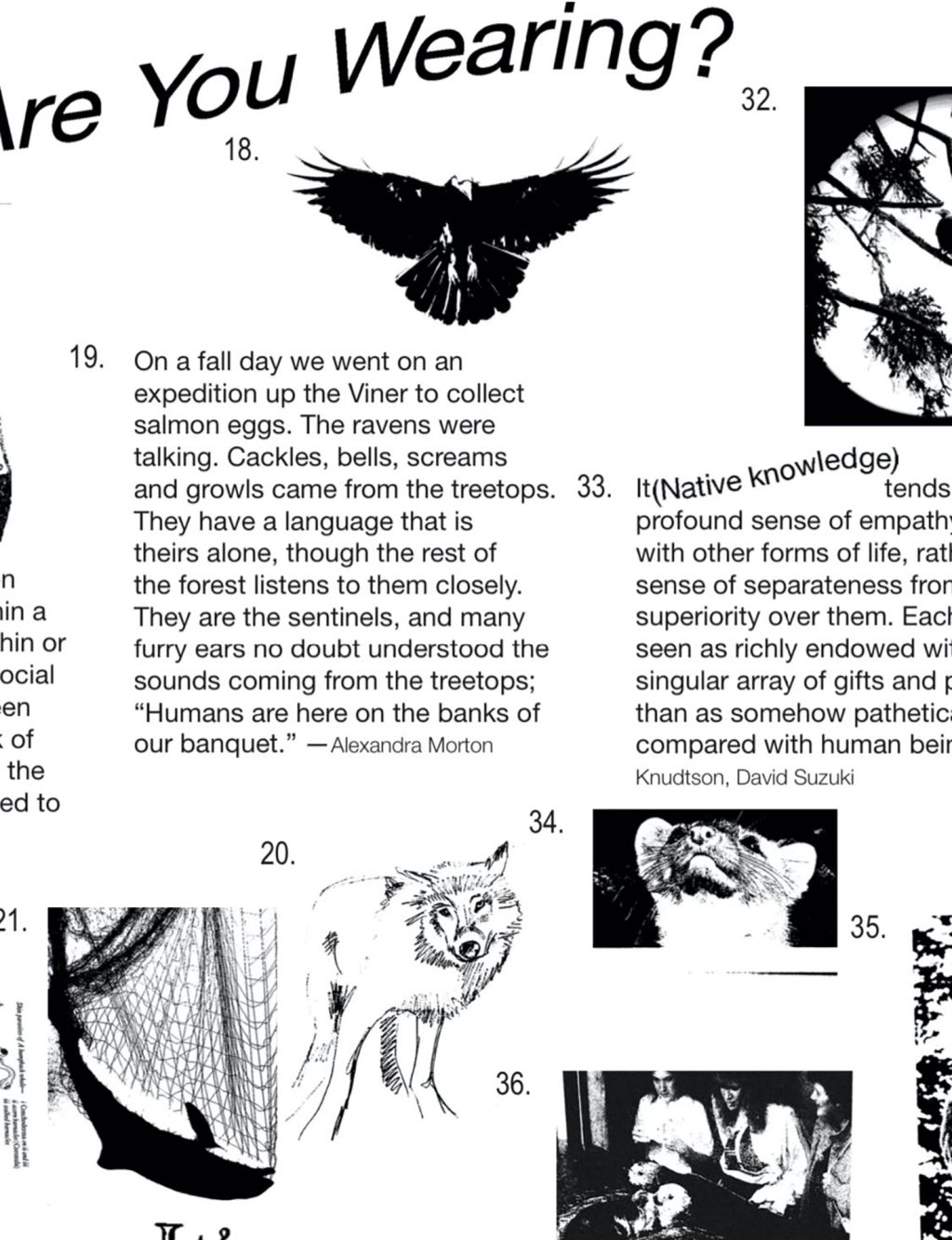Who Are You Wearing? is a research into the relation between humans and nonhuman (or more-than-human) animals in fashion and clothes.
This work uses the representation of animals on garments as a starting point to address human – nonhuman animal relations. By printing an artwork compiled out of information from zoology, philosophy, fashion, animal advocacy (etcetera) over thrifted garments that carry animal references on them, these items invite for a view into the relationalities behind the puma on your sweatshirt.
This work is a collaboration with Alice Alloggio, together with- and in support of, local animal welfare, activist and advocacy organizations.
Edition 01: This edition carries images and text from fashion media, the industry, zoology and animal advocacy, addressing the human-nonhuman relations in fashion. For State of Fashion, the conference Ways of Caring – Practicing Solidarity 2022.
Supported by: ArtEZ Fashion Professorship.
Edition 02: This is a site-specific edition developed in the framework of a short research residency at LAB: Here // Too // For by Material Matters at the Vancouver Art Gallery (August 2023, Canada BC). It is comprised of images and texts about local animals from animal advocates such as Alexandra Morton, David Suzuki, Dawn Dudek, Jackie Hildering, The Marine Detective and the Marine Education & Research Society. The items were available in the Vancouver Art Gallery museum shop. Profits were donated to local animal welfare supporters: Alexandra Morton, and the Marine Education & Research Society.
Supported by: Material Matters, Emily Carr University, Vancouver Art Gallery, Social Sciences and Humanities Research Council of Canada, Creative Industries Fund NL.
The following sourcelists of the prints can be found in tags and labels in the garments.
Edition 01:
- Re-Edition. Winter Spring 2016-2017. London: Idea. p.65
- Haraway, D. (2008) When species meet. Minneapolis/London: Minnesota Press. p.20
- Moussaieff Mason, J. McCarthy, S. (1995) When elephants weep. New York: Dell Publishing. p.42
- Haraway, D. (2008) When species meet. Minneapolis/London: Minnesota Press. p.22
- Vogue UK, September 2019. London: Condé Nast. p.294
- [Online] Available from: https://www.123rf.com/photo_29478598_cow-nurturing-her-calf-in-nature.html [Accessed: 3 June 2022]
- Bainbridge, D. (2020) How zoologists organize things. London: Quatro publishing PLC. p.232
- Haraway, D. (2008) When species meet. Minneapolis/London: Minnesota Press. p.16
- Moussaieff Mason, J. McCarthy, S. (1995) When elephants weep. New York: Dell Publishing. p.16
- Grizmek, B. (1975) Over marters en beren. Utrecht: Uitgeverij Het Spectrum. p.90
- Alpaca cuddling at Bluebird Farm. [Online] Available from: https-//www.onlyinyourstate.com/new-jersey/one-awesome-activity-nj/.jpeg. [Accessed: 14 May 2022]
- Moussaieff Mason, J. McCarthy, S. (1995) When elephants weep. New York: Dell Publishing. p.7
- Cow skin [Online] Available from: https://for-sale.yowcow.com/tanned-cow-hides. [Accessed on 18 May]
- Goose
- Porter UK, Spring 2019. London: Net – A – Porter group. p.158
- Moussaieff Mason, J. McCarthy, S. (1995) When elephants weep. New York: Dell Publishing. p.xxii
- Grizmek, B. (1975) Over marters en beren. Utrecht: Uitgeverij Het Spectrum. p.83
- Grizmek, B. (1975) Over marters en beren. Utrecht: Uitgeverij Het Spectrum. p.12
- Jahn, T. (e.d.) (1966) Brehm’s dierenleven in kleuren. Helmond: Uitgeverij Helmond B.V. p.494
- Angora rabbit. Bungalo of Bunnies Photography. [Online] Available from: https://bungalowofbunnies.weebly.com. [Accessed: 14 May 2022]
- Purple Fashion. Fall winter 2007/2008. Paris/New York: Purple Institute. p.170
- Dunayer, J. (2001) Animal Equality: Language and Liberation. Derwood, MD: Ryce Publishing. p.120-121
- Schippers, H. L. (1998) Konijnen. Lisse: Zuid Boekproducties. p.40
- Sheep and alpaca, by Nora and Lena de Vries
- Vogue UK. October 2017. London: Condé Nast. p.277
- Caterpillar, by Nora and Lena de Vries
- Anatomy of a bird wing
- Haraway, D. (2008) When species meet. Minneapolis/London: Minnesota Press. p.42
- Vogue UK, October 2019. London: Condé Nast. p.228
- Meijer, E. (2017) De soldaat was een dolfijn. Amsterdam: Cossee. p.37
- Duck feet
- DUST, October 2017. Berlin / London
Edition 02:
- Minke whale
- Purple Fashion. Fall winter 2007/2008. Paris / New York: Purple Institute. p.170
- Morton, A. (2002). Listening to Whales, What the Orcas Have Taught Us. New York: Ballantine Books. p.91
- MacDuffee, M. (2020). A Bond Through Salmon, Language and Grandmothers. In Black, M. Hammond, L., Hanke, G., Sanchez, N. (eds.). Spirits of the coast; orcas in science, art and history. Victoria: Royal BC Museum. p.17
- Black bear
- Humpback KC Breaching in Blackney Pass, August 30th 2011. (2011). Credit: Jackie Hildering, www.themarinedetective.com
- Morton, A. (2002). Listening to Whales, What the Orcas Have Taught Us. New York: Ballantine Books. p.5
- Sea Otters
- Humpback identification for Mers. (2011). Credit: Jackie Hildering, Marine Education & Research Society, Marine Mammal License MML-42. www.merssociety.org
- We Are Family. (2014). Credit: Jackie Hildering, Marine Education & Research Society, Marine Mammal License MML-42. www.merssociety.org
- Morton, A. (2002). Listening to Whales, What the Orcas Have Taught Us. New York: Ballantine Books. p.83
- Octopuses Shed Their Suckers! (2020). Credit: Jackie Hildering. www.themarinedetective.com
- Heron
- Mac’s field guide to Northwest Coastal Invertebrates. Seattle: Mounteneer books.
- Dunayer, J. (2001). Animal Equality: Language and Liberation. Derwood, MD: Ryce Publishing. p.98
- A Smack of Jellies. (2020). Credit: Jackie Hildering. www.themarinedetective.com
- Yong, E. (2022). An Immense World, How Animal Senses Reveal the Hidden Realms Around Us. Dublin; Random House. p.7
- Raven
- Morton, A. (2004). Beyond the Whales, The Photographs and Passions of Alexandra Morton. Victoria, TouchWood. pp.124-126
- Wolf
- Ascobans. (2023). Bycatch. [Online] Available from: www.ascobans.org/en/species/threats/bycatch. [Accessed 9/07/2023]
- Barnacle
- It’s not a show. (2022). Illustration by Dawn Dudek for Mers Society. Credit: Dawn Dudek, Marine Education & Research Society. www.merssociety.org
- Sockeye salmon
- Hildering, J. (15/11/2022). It’s Not A Show! [Online]. Available from: https://themarinedetective.com/blog/page/2/. [Accessed 09/07/2023]
- Marten
- Hummingbird
- To Think Before We Click. (2020). Jackie Hildering. Credit: Contributed to Marine Education & Research Society (photographer wants to remain anonymous). www.merssociety.org
- Beaver Pelt
- Orca in captivity. Reuters/Mike Blake
- Outfitters. (2023). Otter fur and pelt. [Online] Available from: www.outfitters.ca/collections/otter-fur-and-pelt. [Accessed 9/07/2023]
- Bald eagle. (2019). Femke de Vries
- Knudtson, P. Suzuki, D. (1992). Wisdom of the Elders. Toronto: Stoddart Publishing Co. Limited. p.15
- Marten
- Cougar
- Sea otters in captivity
- Otter tracks
- Yong, E. (2022). An Immense World, How Animal Senses Reveal the Hidden Realms Around Us. Dublin; Random House. p.15
- Steller Sea Lions. (2010). Credit: Jackie Hildering, www.themarinedetective.com
- Morton, A. (2004). Beyond the Whales, The Photographs and Passions of Alexandra Morton. Victoria, TouchWood Editions Ltd. p.7
- Wolves
- Stanek, V.J. (1966). Wereld der Natuur. Amsterdam: Uitgeverij Pegasus. p.84
